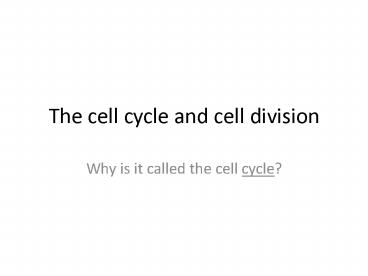The cell cycle and cell division PowerPoint PPT Presentation
Title: The cell cycle and cell division
1
The cell cycle and cell division
- Why is it called the cell cycle?
2
Before the cell can divide, DNA must be copied
- Semiconservative- one old strand, one new strand
- Increases accuracy
After replication
3
The life cycle of a cell
G1 can last for a few minutes or decades
Genes control cell division Loss of control
cancer
4
How do cells die?
programmed cell death
injury
5
The stages of mitosis
What do you get? Two identical cells
6
Why do cells divide?
- So we can get bigger (cells dont get bigger, we
accumulate more cells) - To repair damage
- Reproduction in some organisms
- How many times can cells divide?
- Embryonic stem cells- unlimited
- Differentiated cells- it depends
- Lack of regulation can lead to cancer
- Can we control regulation?
7
Sexual reproduction and meiosis
- Sperm and egg deliver two halves of a genome
- Some terminology
- Gametes sex cells
- Diploid a cell with two copies of each
chromosome - Diploid number 2n
- Haploid a cell with one copy of each chromosome
- Haploid number n
- Meiosis cell division process by which gametes
are formed
8
Karyotype one chromosome comes form each parent
9
Meiosis Two rounds of cell division In humans,
each daughter cell has 23 chromosomes
10
Many possible combinations of chromosomes are
possible
Random assortment Crossing over
11
Not identical in human males and females
Feature Males Females
When does meiosis begin? How long does each step take? Begins at puberty Each step takes about the same time (64 days total) Begins during embryonic development May remain in meiosis I for decades (may never complete meiosis)
How is meiosis completed? Spermatocytes will complete meiosis Meiosis II happens only with fertilization
How many gametes are formed? 4 spermatids are formed One ovum is formed
12
Summary
- The cell cycle is its life history. Not all cells
in the body have the same history. - Cells divide by mitosis to form exact copies of
themselves - Meiosis forms gametes, and is the basis of sexual
reproduction
PowerShow.com is a leading presentation sharing website. It has millions of presentations already uploaded and available with 1,000s more being uploaded by its users every day. Whatever your area of interest, here you’ll be able to find and view presentations you’ll love and possibly download. And, best of all, it is completely free and easy to use.
You might even have a presentation you’d like to share with others. If so, just upload it to PowerShow.com. We’ll convert it to an HTML5 slideshow that includes all the media types you’ve already added: audio, video, music, pictures, animations and transition effects. Then you can share it with your target audience as well as PowerShow.com’s millions of monthly visitors. And, again, it’s all free.
About the Developers
PowerShow.com is brought to you by CrystalGraphics, the award-winning developer and market-leading publisher of rich-media enhancement products for presentations. Our product offerings include millions of PowerPoint templates, diagrams, animated 3D characters and more.

